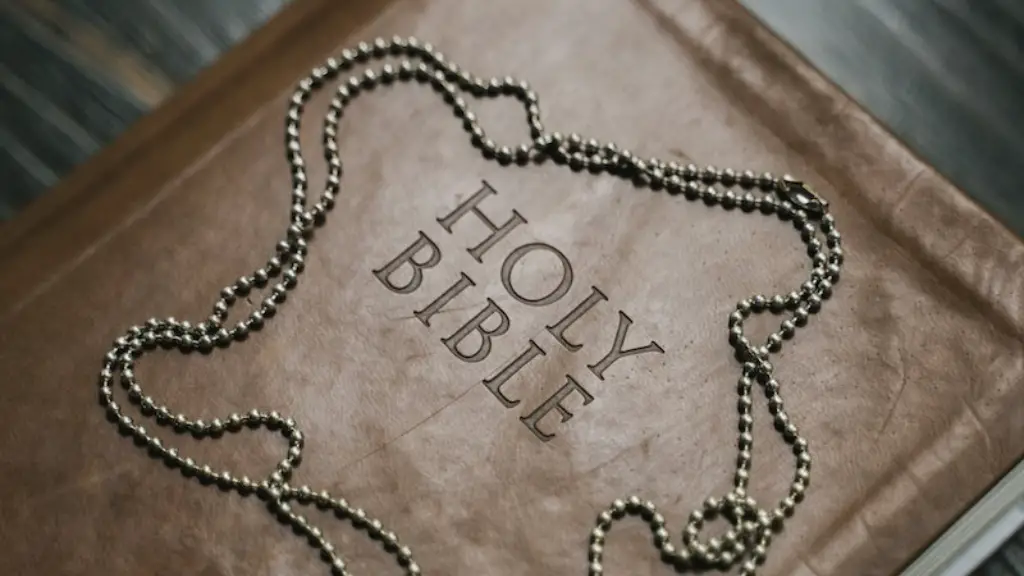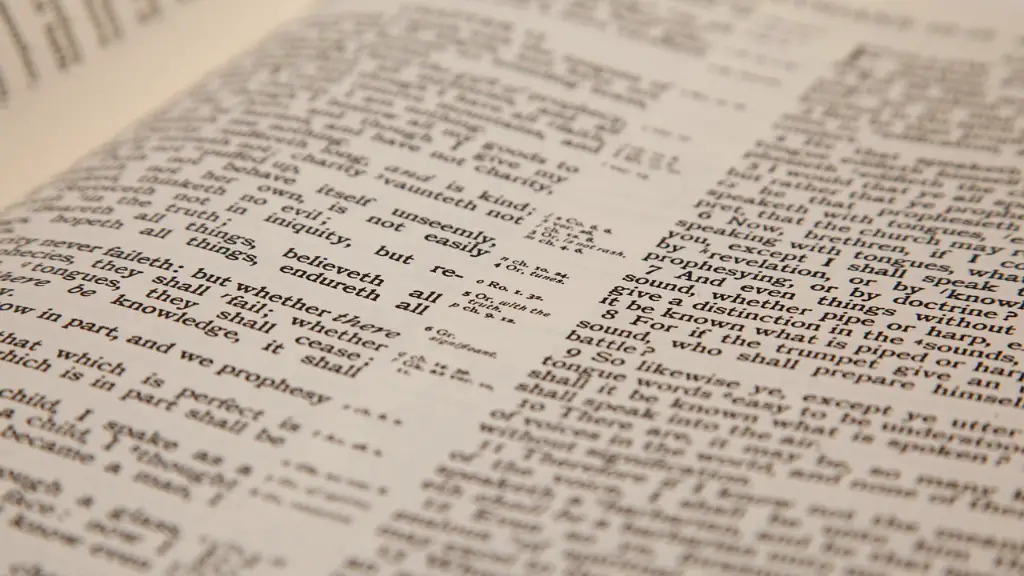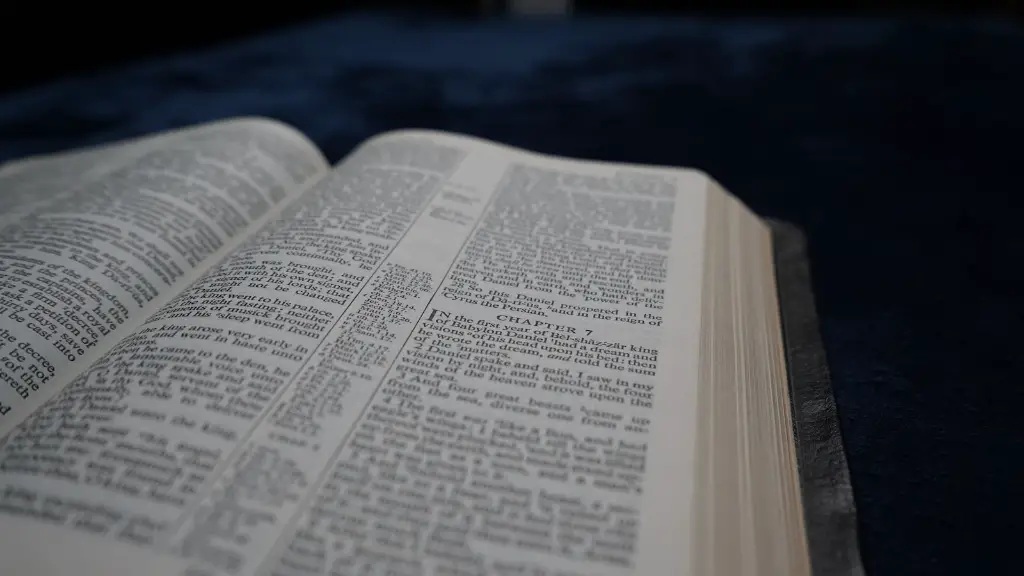The Bible is a collection of religious texts sacred to Christians. It is divided into two parts, the Old Testament and the New Testament, which are then further divided into smaller sections. The Old Testament contains the books of the Hebrew Bible, while the New Testament comprises 27 books, including the Gospels, Acts, and letters from various early Christian leaders.
The Bible is broken down into two main sections: the Old Testament and the New Testament. The Old Testament features the history and stories of the Jewish people, while the New Testament tells of the life, death, and resurrection of Jesus Christ.
What are the 5 sections of the Bible?
These five books are also known as the Torah or the Pentateuch. They were written by Moses and are full of laws and stories about the history of the Jewish people. These books are very important to Judaism, and are studied in great detail by religious scholars.
The Books of Law, also called the Pentateuch or Torah, are the first five books of the Bible. These books are Genesis, Exodus, Leviticus, Numbers, and Deuteronomy. The Historical Books are the next twelve books of the Bible. These books are Joshua, Judges, Ruth, 1 and 2 Samuel, 1 and 2 Kings, 1 and 2 Chronicles, Ezra, Nehemiah, and Esther. The Poetic Books are the next five books of the Bible. These books are Job, Psalms, Proverbs, Ecclesiastes, and Song of Solomon. The Prophetic Books are the last seventeen books of the Bible. These books are Isaiah, Jeremiah, Lamentations, Ezekiel, Daniel, Hosea, Joel, Amos, Obadiah, Jonah, Micah, Nahum, Habakkuk, Zephaniah, Haggai, Zechariah, and Malachi. The New Testament has twenty-seven books which are also divided into four categories. The Gospels are the first four books of the New Testament. These books are Matthew, Mark, Luke, and John. The Historical Book is the next book of the New Testament. This book is the Acts of the Apostles. The Letters
What are the 4 categories of books in the Bible
The word “gospel” comes from the Old English word godspel, which means “good news.” The gospels are the good news of Jesus Christ. The acts of the apostles are accounts of the early church after the resurrection of Christ. The epistles are letters written by the apostles to churches and individuals. The apocalypse is the book of Revelation, which is a vision of the end times.
The Old Testament is the original Hebrew Bible, the sacred scriptures of the Jewish faith, written at different times between about 1200 and 165 BC. The New Testament books were written by Christians in the first century AD.
What are the 4 major themes of the Bible?
The great biblical themes provide a comprehensive overview of God’s character and his interactions with his creation. These themes help us to understand who God is and how he works in the world. They also remind us of his covenant with us and his promises to us. These themes give us hope and comfort in times of trouble and help us to trust in God’s goodness and power.
The Hebrew Bible, also known as the Tanakh, is divided into three sections: the Law, the Prophets, and the Writings. This tripartite structure is reflected in the literature of the Second Temple period (6th–1st century BCE) and the early post-Temple period. The Law includes the books of Genesis, Exodus, Leviticus, Numbers, and Deuteronomy; the Prophets include the books of Joshua, Judges, Samuel, Kings, Isaiah, Jeremiah, Ezekiel, and the twelve minor prophets; and the Writings include the books of Psalms, Proverbs, Job, Song of Songs, Ruth, Lamentations, Ecclesiastes, Esther, Daniel, Ezra-Nehemiah, and Chronicles.
This threefold division is reflected in the literary works of the Second Temple period, which can be divided into three categories: (1) works that reinterpret and expand upon the themes of the Hebrew Bible; (2) works that are inspired by the Bible but do not directly engage with it; and (3) works that are not directly inspired by the Bible but nevertheless reflect some of its themes and ideas.
The first category includes works such as the Dead Sea Scrolls, the books
WHO removed the 7 books from the Bible?
In the 16th century, Martin Luther argued that many of the received texts of the New Testament lacked the authority of the Gospels. He proposed removing a number of books from the New Testament, including Hebrews, James, Jude, and Revelation.
It’s no secret that the Catholic Church has a long and complicated history with the Bible. In recent years, there has been much debate about which books should be included in the Bible and which should not. In 2009, the Vatican removed 14 books from the Bible, sparking a massive controversy.
Now, a Vatican insider has come forward to reveal the truth about why these books were removed. According to this source, the Vatican felt that these books contained content that was not consistent with Catholic doctrine. In particular, they felt that these books contained passages that were critical of the Church or that contradicted Church teachings.
The Vatican has not commented on this story, and it’s unclear if they will ever officially release a statement on why these particular books were removed from the Bible. However, this insider’s account provides a fascinating insight into the inner workings of the Church and the thought process behind one of the most controversial decisions in recent years.
What are the 5 missing books of the Bible
The Forgotten Books of the Bible is a fascinating book that brings to light five ancient biblical texts that are often overlooked. The book provides insight into the meaning of these texts and how they relate to today’s society. The book is a great resource for anyone interested in learning more about the Bible and its message.
The Bible tells the story of humanity’s fall from grace and our subsequent self-destruction. We see this cycle throughout the Old Testament, where humanity time and time again turns away from God and towards our own desires. This ultimately leads to our downfall, as we are unable to maintain our covenant partnership with God. However, the Bible also tells of the Messiah who will come and restore this covenant. This is the hope that we have as Christians, that one day God will once again be reconciled with humanity.
What are the 7 genres of the Bible?
The Bible is a collection of religious texts or scriptures sacred to Christians. It is divided into two parts, the Old Testament and the New Testament. The Old Testament contains the books of the Hebrew Bible, which includes the wisdom literature, the psalms, the prophetic books, and the apocalyptic literature. The New Testament contains the Gospels, the Acts of the Apostles, the Letters of Paul, and the Revelation.
Different religions have different religious texts that they follow. The Bible is the main religious text for Christianity, the Qur’an is the main religious text for Islam, the Gita is the main religious text for Hinduism, the Torah is the main religious text for Judaism, the Guru Granth Sahib is the main religious text for Sikhism, and the Tripitaka is the main religious text for Buddhism. Each of these religious texts contains the beliefs and teachings of their respective religion.
What is the format of the Bible
A common format for biblical citations is Book chapter:verses, using a colon to delimit chapter from verse, as in: “In the beginning, God created the heaven and the earth” (Gen 1:1).
The Bible is divided into two major divisions: The Old Testament and the New Testament. The Old Testament consists of thirty-nine books and the New Testament is made up of twenty-seven books, a total of sixty-six books all together.
What are the 8 sections of the Bible?
The Law, also known as the Pentateuch or the Five Books of Moses, is the first section of the Bible. It includes the books of Genesis, Exodus, Leviticus, Numbers, and Deuteronomy.
The second section of the Bible is known as the Historical Books. It includes the books of Joshua, Judges, Ruth, 1 & 2 Samuel, 1 & 2 Kings, 1 & 2 Chronicles, Ezra, Nehemiah, and Esther.
The third section, known as the Poetic Books, includes the books of Job, Psalms, Proverbs, Ecclesiastes, and the Song of Solomon.
The fourth section is known as the Prophetic Books. It includes the books of Isaiah, Jeremiah, Lamentations, Ezekiel, and Daniel.
The fifth section is known as the Gospels. It includes the books of Matthew, Mark, Luke, and John.
The sixth section is known as the Acts of the Apostles.
The seventh section is known as the Epistles. It includes the books of Romans, 1 & 2 Corinthians, Galatians, Ephesians, Philippians, Colossians, 1 & 2 Thessalonians, 1 & 2 Timothy
In The 3 Keys to the Kingdom: Binding, Loosing, and Knowledge, Mary Garrison shares the wisdom she’s gathered during her years of ministry. She explains how these three keys are essential for living a successful Christian life. Garrison provides examples of how each key can be used in our everyday lives.
Warp Up
The Bible is typically broken down into two major sections: the Old Testament and the New Testament. Each section is then further divided into smaller books, chapters, and verses.
The Bible is divided into the Old Testament and the New Testament. The Old Testament contains the books of the Hebrew Bible, which were written before the time of Jesus Christ. The New Testament contains the books of the Christian Bible, which were written after the time of Jesus Christ.





